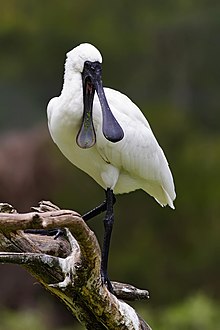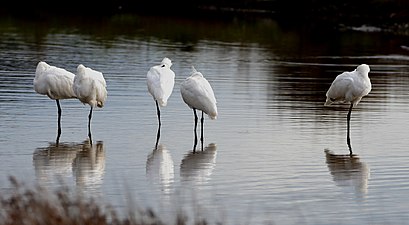Royal spoonbill
| Royal spoonbill | |
|---|---|

| |
| Royal spoonbill with open beak | |
| Scientific classification | |
| Domain: | Eukaryota |
| Kingdom: | Animalia |
| Phylum: | Chordata |
| Class: | Aves |
| Order: | Pelecaniformes |
| Family: | Threskiornithidae |
| Genus: | Platalea |
| Species: | P. regia
|
| Binomial name | |
| Platalea regia Gould, 1838
| |
The royal spoonbill (Platalea regia) also known as the black-billed spoonbill, occurs in
Taxonomy
The renowned ornithologist John Gould first described the royal spoonbill in 1838, naming it Platalea regia and noting its similarity to the Eurasian spoonbill (P. leucorodia).[2] A 2010 study of mitochondrial DNA of the spoonbills by Chesser and colleagues found that the royal and black-faced spoonbills were each other's closest relatives.[3]
Description
The royal spoonbill is a large, white bird with a black, spoon-shaped bill. It is approximately 80 cm (31 in) tall, 74–81 cm (29–32 in) and a weight of 1.4–2.07 kg (3.1–4.6 lb).
The end of the bill of the royal spoonbill is broader and works more like a pair of tongs than the narrower bill of the yellow-billed spoonbill, which acts like a forceps.[6]
Feeding

The royal spoonbill is carnivorous, catching small animals by sweeping its bill through shallow water and swallowing prey once detected. When slow sweeping, the spoonbill walks slowly with the bill perpendicular to the water surface (i.e. vertical) with the bill tip open about 2 to 4 cm (1 to 1.5 in), sweeping an arc of around 100 degrees in front of the bird. The bird walks slowly, kicking up debris and small animals from the bottom of the body of water, which it senses and catches with its bill. When an item is sensed, the spoonbill switches to intensive sweeping of a small area.[6] Royal spoonbills also probe submerged plants directly for prey, and seize prey such as spiders above ground. They have also been observed dragging their bills through shallow water alongside them while walking.[6]
Prey items recorded at
Breeding
When they are breeding, long white plumes grow from the back of their heads and coloured patches appear on the face. The nest is an open platform of sticks in a tree in which the female lays two or three eggs. The chicks hatch after 21 days. The birds are highly sensitive to disturbance in the breeding season. In Australia, whole colonies have been known to desert their eggs after a minor upset.
Gallery
References
- . Retrieved 19 November 2021.
- ^ Gould, John (1865). Handbook to The birds of Australia, Volume 2. self. p. 287.
Gould regia.
- S2CID 33352904.
- ^ [1] (2011).
- ISBN 978-0-8493-4258-5.
- ^ .
Further reading
- Kahl, M. Philip (February 1987). "The Royal Spoonbill". OCLC 643483454.










